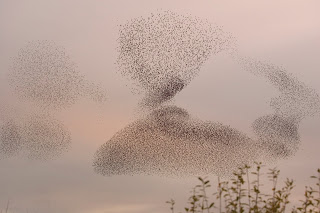The RSPB is warning that there are dark clouds forming overhead this autumn. But thankfully rather than meaning something foreboding they form part of one of the UK’s most incredible wildlife spectacles.
Hundreds of thousands of starlings will turn the sky black around the UK in the next few weeks, as they come together in huge clouds, wheeling and swooping in unison.
The jaw-dropping wildlife exhibition, known as a ‘murmuration’ can be seen on many of the RSPB’s nature reserves and other sites, and the wildlife charity is organising up close and personal viewings.
One of the most popular sites to see starlings is RSPB Leighton Moss, Silverdale, Lancashire.
Many of the autumn roosts are already forming well, and more and more will flock together as the weeks go on, with numbers swelling to around 100,000 in some places.
Hundreds of thousands of starlings will turn the sky black around the UK in the next few weeks, as they come together in huge clouds, wheeling and swooping in unison.
The jaw-dropping wildlife exhibition, known as a ‘murmuration’ can be seen on many of the RSPB’s nature reserves and other sites, and the wildlife charity is organising up close and personal viewings.

One of the most popular sites to see starlings is RSPB Leighton Moss, Silverdale, Lancashire.
Many of the autumn roosts are already forming well, and more and more will flock together as the weeks go on, with numbers swelling to around 100,000 in some places.
Early evening, just before dusk, is the best time to see them as they choose their communal night time shelter.
The huge gatherings are at their largest in winter, as they are boosted by thousands of migrant birds visiting from the European continent for Britain's milder Atlantic climate.
They join forces for safety in numbers in case of predators and to keep warm at night. They also exchange information, such as good feeding areas. They often feed miles away from where they roost and return each evening. On many sites you can almost set your watch by their arrival.
But despite the incredible size of the flocks, these numbers are just a fraction of what they used to be.
Crashes in the starling population of over 70% in recent years mean they are now on the critical list of UK birds most at risk.
The decline is believed to be because of loss of permanent pasture, increased use of farm chemicals and a shortage of food and nesting sites in many parts of the UK.
Johann Holt, RSPB Visitor Services Adviser says: “The starling roost is one of the most incredible natural spectacles we enjoy here in the UK and they are so easy to see. In many cases they are like clockwork – you know that at certain time in the evening the sky will start to turn black and its mesmerizing watching the flock grow and grow.”
Of course the best local place for us is the Runcorn Bridge. Chris

No comments:
Post a Comment